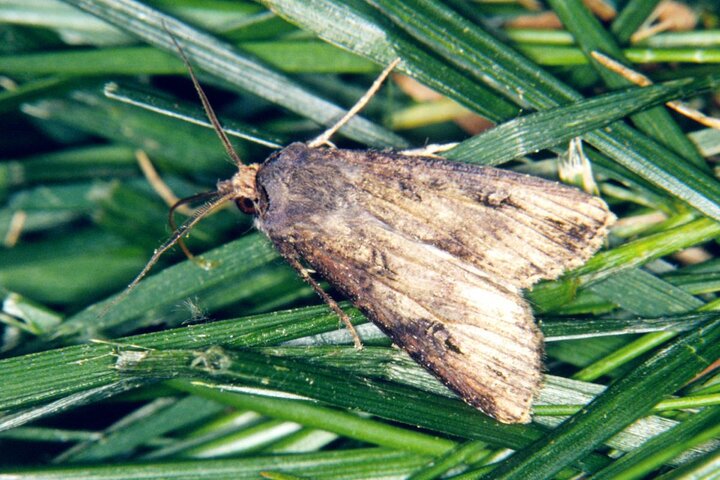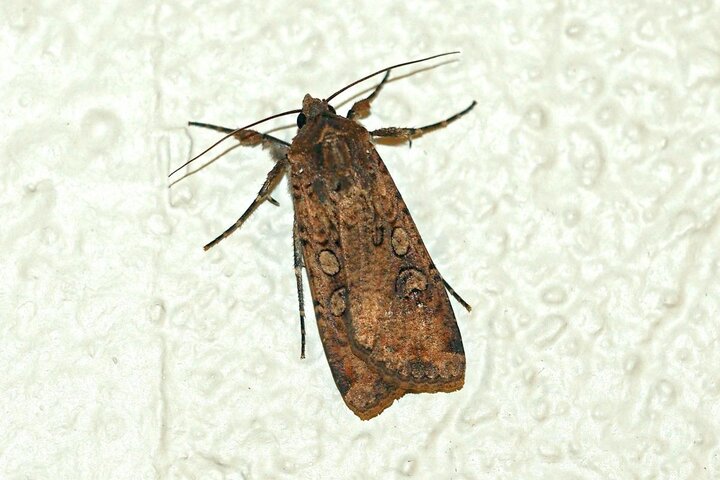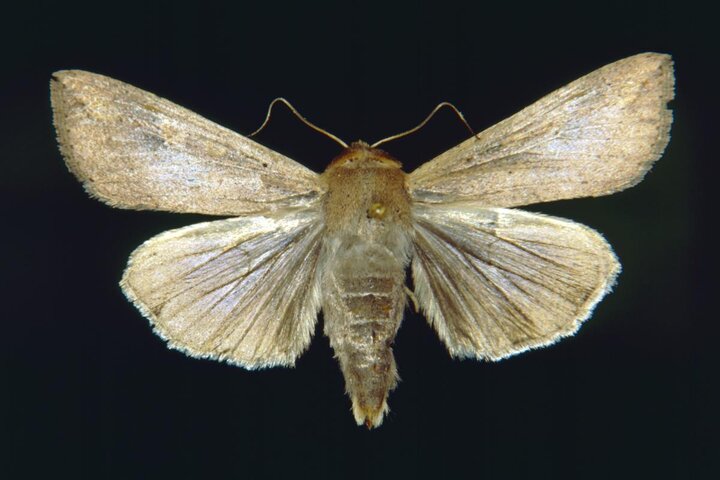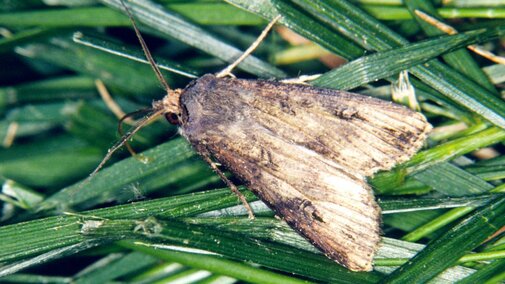Pheromone traps have been established at several locations in eastern Nebraska to monitor for several spring migrants to Nebraska; black cutworm, variegated cutworm and true armyworm moths. Nebraska Extension faculty Wayne Ohnesorg, Ron Seymour, Gary Lesoing, Laura Thompson and Justin McMechan are monitoring pheromone traps in their areas.
Pheromone trapping is useful for determining the presence of different species in our area, but cannot be used to make treatment recommendations. Rather it is an early warning that we should be monitoring for the larvae of these moths which may be found in our crop fields.
See NebGuide G1153, Corn Cutworms, for more information.
May 20, 2020 Trapping Update
The following are updated cutworm moth trapping results through May 20th.
| Total Cutworm Moth Capture Per Week | ||||||||||||||||||||||
|---|---|---|---|---|---|---|---|---|---|---|---|---|---|---|---|---|---|---|---|---|---|---|
| April 5-11 | April 12-18 | April 19-25 | April 26 - May 2 | May 3-9 | May 10-16 | May 17-20 | ||||||||||||||||
| County | Location | Black | Variegated | Armyworm | Black | Variegated | Armyworm | Black | Variegated | Armyworm | Black | Variegated | Armyworm | Black | Variegated | Armyworm | Black | Variegated | Armyworm | Black | Variegated | Armyworm |
| Adams | Hastings | - | - | - | - | - | - | - | - | - | 1 | 41 | 0 | 0 | 11 | 0 | 1 | 0 | 0 | - | - | - |
| Lancaster | Hickman | 0 | 9 | 1 | 0 | 1 | 2 | 1 | 0 | 0 | 1 | 0 | 0 | 0 | 0 | 0 | 0 | 8 | 0 | 0 | 0 | 0 |
| Madison | Norfolk | - | - | - | - | - | - | - | - | - | - | - | - | 5 | 7 | 0 | 3 | 3 | 4 | - | - | - |
| Nemaha | Auburn | 0 | 2 | 2 | 0 | 0 | 1 | 10 | 0 | 1 | 1 | 2 | 1 | 0 | 5 | 0 | 0 | 1 | 0 | 0 | 1 | 0 |
| Nemaha | Johnson | 0 | 7 | 2 | 1 | 1 | 0 | 1 | 0 | 2 | 6 | 0 | 1 | 0 | 9 | 0 | 0 | 3 | 3 | 1 | 0 | 1 |
| Otoe | Palmyra | 0 | 9 | 4 | 0 | 5 | 5 | 0 | 0 | 1 | 0 | 9 | 0 | 0 | 5 | 0 | 1 | 0 | 0 | 0 | 0 | 0 |
| Richardson | Falls City | 1 | 3 | 2 | 0 | 2 | 2 | 0 | 0 | 0 | 4 | 0 | 0 | 0 | 2 | 0 | 0 | 2 | 0 | - | - | - |
| Saunders | ENREC | 4 | 2 | 0 | 1 | 3 | 1 | - | - | - | - | - | - | - | - | - | - | - | - | - | - | - |
We continue to capture moths in our pheromone trapping network. We received a significant capture of black cutworm moths at Auburn on April 23 (Table 1.2). A significant capture is defined as 8 or more moths over 2 nights. A significant capture is used to initiate the degree day model described below (Table 2).
Based on average temperatures at Auburn, we expect that 300 degree days will be reached by May 18. This is the point that black cutworm larvae emerging from eggs laid by these moths will be big enough to begin cutting corn stems.
If you are not routinely monitoring fields for cutworm feeding, this is a good time to target initiation of scouting in the Auburn area. Remember that we have several other cutworm species in Nebraska that overwinter as larvae, so it is always a good idea to scout corn beginning at emergence for cutworm injury and other early season pests, regardless of pheromone trap captures.
| Total Cutworm Moth Capture Per Week | |||||||||||||
|---|---|---|---|---|---|---|---|---|---|---|---|---|---|
| April 5-11 | April 12-18 | April 19-25 | April 26-29 | ||||||||||
| County | Location | Black | Variegated | Armyworm | Black | Variegated | Armyworm | Black | Variegated | Armyworm | Black | Variegated | Armyworm |
| Adams | Hastings | - | - | - | - | - | - | - | - | - | 1 | 19 | 0 |
| Lancaster | Hickman | 0 | 9 | 1 | 0 | 1 | 2 | 1 | 0 | 0 | 1 | 0 | 0 |
| Madison | Norfolk | - | - | - | - | - | - | - | - | - | - | - | - |
| Nemaha | Auburn | 0 | 2 | 2 | 0 | 0 | 1 | 10 | 0 | 1 | 1 | 2 | 1 |
| Nemaha | Johnson | 0 | 7 | 2 | 1 | 1 | 0 | 1 | 0 | 2 | 6 | 0 | 2 |
| Otoe | Palmyra | 0 | 9 | 4 | 0 | 5 | 5 | 0 | 0 | 1 | 0 | 0 | 0 |
| Richardson | Falls City | 1 | 3 | 2 | 0 | 2 | 2 | 0 | 0 | 0 | 4 | 0 | 0 |
| Saunders | ENREC | 4 | 2 | 0 | 1 | 3 | 1 | - | - | - | - | - | - |
We are starting to see low levels of these moths at several locations in Nebraska (Table 1.1).
| Total Cutworm Moth Capture Per Week | ||||||||||
|---|---|---|---|---|---|---|---|---|---|---|
| April 5-11 | April 12-18 | April 19-22 | ||||||||
| County | Location | Black | Variegated | Armyworm | Black | Variegated | Armyworm | Black | Variegated | Armyworm |
| Adams | Hastings | - | - | - | - | - | - | - | - | - |
| Lancaster | Hickman | 0 | 9 | 1 | 0 | 1 | 2 | 0 | 0 | 0 |
| Madison | Norfolk | - | - | - | - | - | - | - | - | - |
| Nemaha | Auburn | 0 | 2 | 2 | 0 | 0 | 1 | 1 | 0 | 1 |
| Nemaha | Johnson | 0 | 7 | 2 | 1 | 1 | 0 | 1 | 0 | 1 |
| Otoe | Palmyra | 0 | 9 | 4 | 0 | 5 | 5 | 0 | 0 | 0 |
| Richardson | Falls City | 1 | 3 | 2 | 0 | 2 | 2 | 0 | 0 | 0 |
| Saunders | ENREC | 4 | 2 | 0 | 1 | 3 | 1 | - | - | - |
GDD Model for Black Cutworm
In the case of the black cutworm, research has developed a degree-day model (Table 2) to predict when cutworms will be large enough to cut corn stems. At that time, more intense scouting is recommended. In Nebraska we have several other cutworm species that overwinter in the state, so scouting at corn emergence is recommended.
| Cumulative degree days | Black cutworm stage | Black cutworm activity |
|---|---|---|
| 0 (biofix) | Significant moth capture* | Egg Laying |
| 90 | Egg hatch | |
| 91-311 | 1st-3rd instar | Leaf feeding |
| 312-364 | 4th instar | Cutting begins |
| 365-430 | 5th instar | Cutting |
| 431-640 | 6th instar | Cutting |
| 641-989 | Pupa | No feeding |
*Significant moth capture is defined as 8 or more moths over two nights
Cutworm Moth Descriptions
Adults of the black cutworm have a drab gray or brownish appearance with two black wedge-shaped markings near the end of the forewing (Figure 1). The hind wings are lighter in color, generally whitish with grey to brown shading.
Variegated cutworm moths are also generally drab, with a variable tan, gray or brown coloration on the front wings (Figure 2). Often the markings are indistinct, but the outer margin of the front wing has seven black notches of which the first four and last two appear paired. The hind wing has a pearly gray appearance.
Adult armyworm moths are generally tan or light brown in color (Figure 3). The front wings are usually specked with black spots and possess a small white spot centrally. The hind wings are similarly tan to grayish-brown, and usually lighter towards the base of the wing.




